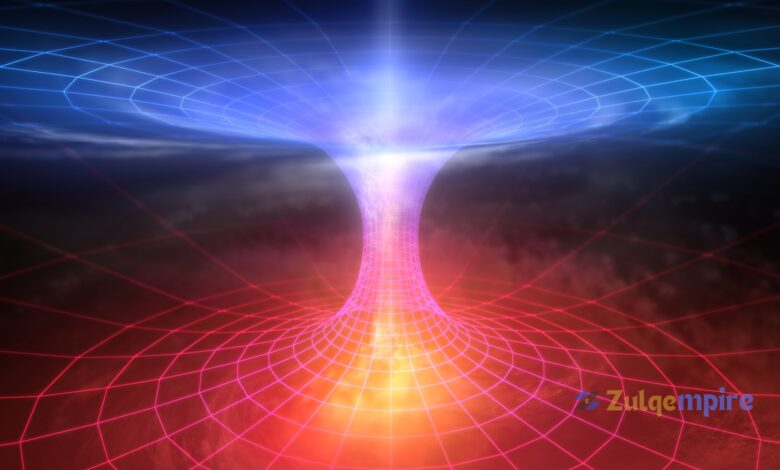Wormholes: Science Fiction to Fusion Reactors?

Science fiction writers have long been enchanted by Wormholes Science Fiction, those fascinating passages across spacetime predicted by Einstein’s equations. They provide the alluring prospect of space travel that may cover enormous distances in a fraction of the time required by traditional transportation. On the other hand, there is no hard proof of wormholes, and their existence is still buried in intricate physics.
A new idea, however, has rekindled interest in wormholes, taking them out of the domain of science fiction and into that of possible practical uses, most notably nuclear fusion. Theoretically, wormholes might release superheated plasma, an essential component for maintaining atomic fusion—the process that generates stellar power.
Understanding Wormholes: Spacetime Bridges
Theoretically, wormholes link two distinct locations in spacetime. See spacetime as a trampoline stretched out before you. A large celestial body, such as a star, would induce the cloth to indent, resulting in a depression. A wormhole connecting two faraway locations on the curved surface would essentially dig a tunnel through this depression.

Wormholes could theoretically exist, but in Einstein’s general theory of relativity, their formation and maintenance rely heavily on exotic matter, an imaginary substance with a negative energy density. Since this strange stuff has never been seen up close, the idea that wormholes can be traversed is entirely speculative.
Theory: Wormholes as cosmic exhaust pipes
An article in [insert name of scientific publication here] presents the new idea, which offers a different take on wormholes. Researchers suggest that a wormhole, created mechanically or naturally, would not be a static path. The alternative is that it might release matter and energy from the opposite end of the connection, much like a cosmic exhaust pipe.
Theoretically, this ejection is caused by the tremendous gravitational forces close to a wormhole. These forces cause stuff to undergo tremendous stretching and compression as it gets closer to the wormhole. Tidal forces can superheat matter to extremely high temperatures, which could be sufficient for nuclear fusion.
Superheated Plasma: Fusion Fuel

A significant quantity of energy is released during nuclear fusion, which occurs when lighter atomic nuclei unite to generate heavier ones. Solar systems like ours rely on this very mechanism for their power. Nevertheless, the achievement of continuous fusion on our planet presents a formidable obstacle.
The production and containment of scorching plasma, a material state in which electrons are removed from atoms to create a charged mixture of ions and electrons, is a significant obstacle. Fusion necessitates temperatures in the millions of degrees Celsius, which are hot enough to evaporate any typical material container.
Also Read: Earth-Sized Planet Found: Possible Life Habitat on Long-Lived Star
Wormhole-Generated Plasma’s Appeal
According to the hypothesis, superheated plasma might be directly ejected from the universe through a wormhole that functions as an exhaust pipe. It is possible to collect this plasma, which is already fused from the intense conditions close to the wormhole, and use it in an Earth fusion reactor.
There would be significant benefits to such a situation. We may access a widely available source of fusion fuel without having to produce and control extremely high temperatures ourselves. With this, we may access an endless supply of renewable energy that might completely alter the energy production industry.
Challenges and Considerations: A Long Road

The idea raises exciting possibilities, but we must not lose sight of the enormous obstacles. Wormholes, in general, much less ones that can be traversed or maintained, are still in the realm of pure theory, as previously stated. We also lack the technology to control or use Wormhole’s Science Fiction for our objectives.
Furthermore, the notion makes one wonder how stable a wormhole that releases superheated plasma can be. Could one command or guide such an ejection? Is there anything risky about tinkering with something that has such tremendous gravitational pull?
Theory Significance: Pushing Boundaries
The theory of Wormholes, Science Fiction, and fusion is essential for several reasons, notwithstanding the difficulties. First, it shows that scientists are still trying to figure out how to use far-fetched ideas from exotic physics. Second, it points out how clever scientists are in expanding our knowledge of the cosmos.
Suppose the use of wormhole plasma for fusion as a whole turns out to be impractical. In that case, the theory still has the potential to spark investigations into other approaches to achieving and regulating fusion. Ultimately, we can succeed more in our search for renewable energy sources if we dabble in the unexpected.
Nuclear Fusion and Wormhole Research Future
We are still looking for signs of wormholes. Astronomers scan the cosmos to detect them for peculiarities that could deform spacetime. Nevertheless, definitive proof is still lacking. Nuclear fusion is still a topic of active investigation. Magnetic confinement fusion (in stellarators and tokamaks) and inertial confinement fusion are two exciting new directions being investigated.




